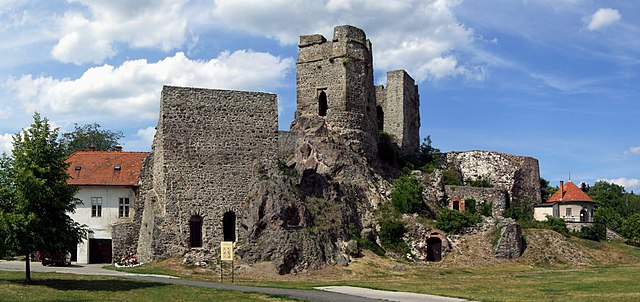Levice
Town in Nitra Region, Slovakia From Wikipedia, the free encyclopedia
Town in Nitra Region, Slovakia From Wikipedia, the free encyclopedia
Levice (Slovak pronunciation: [ˈleʋitse] ; Hungarian: Léva, Hungarian pronunciation: [ˈleːvɒ]; German: Lewenz) is a town in western Slovakia. The town lies on the left bank of the lower Hron river. The Old Slavic name of the town was Leva, which means "the Left One".
Levice | |
|---|---|
Town | |
From the top, Levice Castle, Levice Town Hall, Saint Michael church in Levice | |
| Coordinates: 48°12′59″N 18°36′29″E | |
| Country | |
| Region | |
| District | Levice District |
| First mentioned | 1156 |
| Government | |
| • Mayor | RNDr. Ján Krtík |
| Area | |
| • Total | 61.00 km2 (23.55 sq mi) |
| (2022) | |
| Elevation | 165 m (541 ft) |
| Population | |
| • Total | 31,081 |
| • Density | 510/km2 (1,300/sq mi) |
| Time zone | UTC+1 (CET) |
| • Summer (DST) | UTC+2 (CEST) |
| Postal code | 934 01[2] |
| Area code | +421 36[2] |
| Car plate | LV |
| Website | levice.sk |
The town is located in the north-eastern corner of the Danubian Lowland (Podunajská nížina), 110 kilometres (68 miles) east of Bratislava, 40 kilometres (25 miles) south-east of Nitra, 32 kilometres (20 miles) south-west of Banská Štiavnica, 55 kilometres (34 miles) south-west of Zvolen and 25 kilometres (16 miles) from the border with Hungary.
It is the capital of the Levice District, which is the largest district in Slovakia at 1,551 square kilometres (599 square miles). The town's heraldic animal is lion (in Slovak lev), and the town's colours are green and yellow.

Levice is first mentioned as Leua, one of the villages belonging to the parish of St. Martin's Church in Bratka (Hungarian: Baratka) in 1156. It was part of the comitatus Tekov (Bars).
First attacked by the Turks in 1544, the town was set on fire while the castle was left unharmed. Between 1581 and 1589, the settlement was the seat of the Captaincy of Lower Hungary. The town was captured by the Turks in 1663 but recaptured only a year later by the Imperial Army led by General de Souches in the Battle of Levice, which took place beneath the town's castle.

During the anti-Habsburg revolution of 1709, the fort was blown up by kuruces. After the break-up of Austria-Hungary, the town became a part of Czechoslovakia (confirmed by the Treaty of Trianon in 1920). As part of the breakup of Czechoslovakia under the Munich Agreement in World War II, the town again belonged to Hungary from 1938 to 1945. At the end of the Second World War it was returned to the restored Czechoslovakia. In 1993 it became part of present-day Slovakia.
It was the hometown of Hungarian-American Eugene Fodor (1905–1991), the founder of Fodor's travel book company.
Census 2021: 31,974 inhabitants (100%)
Roman Catholic (majority), Reformed Protestant (Calvinist), Moravian Brethren (the biggest congregation in Slovakia), Lutheran, Baptist, Old Catholic Church, Adventist of the 7th Day, Modrý kríž (Blue Cross), several Charismatic and Pentecostal communities, Jehovah's Witnesses, Muslim community (non-practising), Jewish community (non-practising), atheists

Textiles, cosmetics, furniture, products from locally obtained Golden Onyx, machinery and construction components, cereals, meat, eggs, dairy products, soft drinks, malt, wine (Levická frankovka is a trademark for locally produced red-wine). One of Slovakia's two nuclear power plants is in Mochovce, 12 kilometres (7.5 miles) north-west of Levice.
There are 8 elementary schools (7 secular including 1 Hungarian, and 1 Roman Catholic school), Gymnazium Andreja Vrabla, a general High School, a Hungarian Calvinist High School (Lyceum), a Business Academy, a Pedagogical and Social Academy, a Secondary Technical School, a Secondary Agricultural School and various apprentice schools.



Seamless Wikipedia browsing. On steroids.
Every time you click a link to Wikipedia, Wiktionary or Wikiquote in your browser's search results, it will show the modern Wikiwand interface.
Wikiwand extension is a five stars, simple, with minimum permission required to keep your browsing private, safe and transparent.